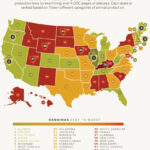In the modern digital landscape, platforms like TikTok and Instagram have transformed the way content is created and consumed. These platforms have undeniably revolutionized social media engagement, allowing users to capture and share remarkable, absurd, and sometimes, problematic clips with the world. Among the myriad of trends, a haunting phenomenon has emerged: a troubling appreciation for content that showcases, or even trivializes, animal cruelty. Whether it’s a trending challenge that involves distressing treatment of pets or sensationalized wildlife encounters, the issue is glaring; but why do these platforms appear to turn a blind eye?
At the crux of this conundrum lies the intricate relationship between user engagement and algorithmic amplification. The algorithms powering these social media giants are meticulously designed to prioritize content that evokes strong reactions—be it laughter, shock, or outrage. The deeper the engagement, the more visible the content becomes. Regrettably, this drive for virality can lead to the promotion of videos that depict animal suffering, capturing attention while neglecting ethical considerations. In this relentless pursuit of likes, shares, and views, the welfare of animals can become an afterthought, almost a collateral damage in the grand scheme of social media stardom.
This dynamic feeds into a larger cultural narrative that often glorifies sensationalism over substance. Animal cruelty content is frequently packaged and marketed under the guise of entertainment. Videos depicting pets in humorous predicaments or exotic animals in comical situations may veil underlying cruelty and deprivation. An audience accustomed to visual gratification may overlook—if not endorse—instances of harm, believing that these portrayals exist purely for amusement. This normalization of distressing content may elucidate why platforms have been slow to implement stringent measures against animal cruelty.
Moreover, the sheer volume of content generated on these platforms creates a daunting challenge for moderators and policymakers. TikTok and Instagram host billions of videos daily. Policing this influx for offensive material, especially where animal abuse is concerned, requires extensive resources and perhaps an introspective shift in how content moderation is approached. The current mechanisms may be ill-equipped for rigorous enforcement, particularly against nuanced representations of cruelty that can sometimes fall into gray areas of policy violations. Lax enforcement perpetuates the cycle, enabling harmful behavior to flourish in plain sight.
Another factor to consider is the platform-centric culture that blurs the line between genuine concern and performative activism. As the trend of “slacktivism” gains momentum, some users may engage with animal cruelty content by liking, sharing, or commenting, under the pretense of raising awareness. However, this superficial engagement rarely translates into meaningful change or understanding of the complex realities faced by animals. The emphasis on eye-catching content may overshadow the ethical responsibilities of social media users, inadvertently condoning the circumvention of animal rights.
There is also a sinister allure associated with the violation of norms. Content that deviates from societal expectations often attracts curiosity and intrigue. Videos that display perilous animal antics or reckless human-animal interactions can evoke a curious response, crafting a dangerous narrative where gravity is overshadowed by the thrill of the unconventional. This collective fascination feeds a feedback loop where creators might feel emboldened to push boundaries further, producing increasingly shocking content to capture attention.
The desensitization of audiences is another pivotal aspect worthy of examination. Continuous exposure to disturbing imagery, whether intended for comedic effect or otherwise, can dull sensitivity towards suffering. Viewers may become immune to the distress depicted in these videos, mistakenly rationalizing the content as mere entertainment or fodder for viral trends. Consequently, the ethical boundaries that once governed interactions with animals may blur, propelling a culture that not only tolerates but actively promotes acts of cruelty in pursuit of digital capital.
Looking beyond the platforms themselves, societal attitudes towards animals play a critical role in this discourse. The commodification of animals in the media—portrayed as accessories for human amusement or as trend-worthy objects—reinforces an ideology that devalues their existence outside of human benefit. This detachment allows for the perpetuation of harmful norms. Change necessitates an understanding that animals are sentient beings deserving of respect, recognition, and rights, not mere subjects for fleeting social media fame.
Ultimately, the question remains: what can be done to combat this alarming trend? The response must encompass a multi-faceted approach. Social media platforms should strive for enhanced algorithms that prioritize the promotion of ethical content, while committing substantial resources to enforce stricter content moderation policies. Additionally, promoting awareness campaigns that underline the significance of compassionate animal treatment can recalibrate public perception—encouraging users to engage thoughtfully rather than frivolously with animal-related content.
The path forward hinges on a collective effort to reshape narratives surrounding animal welfare in social media. Users wield the power to demand change within these platforms, advocating for a digital landscape that values ethical considerations over ephemeral shocks. By critically examining consumption habits, rejecting cruelty-oriented content, and promoting compassion, a new chapter in the online discourse around animal rights can emerge—one that prioritizes empathy, respect, and genuine care for all living beings.







